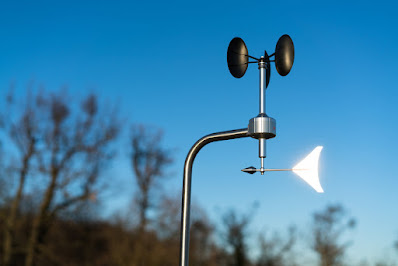 |
| Anemometers |
An anemometer is a tool for determining wind speed and direction. It is also the most frequent device used in weather stations. The word anemos is Greek in origin, and this phrase is derived from it. The meaning of this word is wind. In meteorology, it also refers to any wind speed instrument. An anemometer is a device that monitors wind speed and pressure. Meteorologists must research weather patterns because they are crucial. They're also crucial to physicists' research into air flow.
The most common type of constant-temperature instrument is the hot wire
anemometer. It comprises of a fine-wire element (0.00016 inch in diameter and 0.05 inch length) that is electrically heated and supported by needles at both ends. While hot wire metres are suitable for clean gases moving at moderate speeds, venturi metres can be used for some liquid (including slurry) flow applications.
Types of AnemometersAnemometers are used to measure wind speed and come in a variety of shapes and sizes. Anemometers are divided into two types: portable handheld anemometers and anemometers attached to the ground at weather stations. Digital anemometers are a type of portable handheld anemometer. Cup anemometers, hot wire anemometers, ultrasonic anemometers, pressure tube anemometers, and laser Doppler anemometers are all types of anemometers. Let's go over the different types of anemometers.
Cup anemometer or rotational anemometer: Cups are put on the vertical axis. Cups spin due to wind pressure. The wind speed is determined by the rate at which the cups revolve. Educational institutions, researchers, and meteorologists all utilise them.
Anemometers with a hotwire or a thermal flow: It measures both wind speed and pressure. The most popular applications for this sort of technology in businesses are heating, ventilation, and air conditioning.
Ultrasonic anemometers:It's a square anemometer with four sensors in a square design.
Windsock or pressure tube anemometer: It determines wind direction and speed based on how high the tube rises above the ground. It's typically found around airports.
Windmill anemometer: It measures both the direction and the speed of the wind. The propeller is attached to the front of the gadget, while a huge tail is attached to the back. It does not have a wind speed metre, but the speed with which the propeller revolves shows the wind speed.
Laser Doppler: The Doppler Effect is used in this anemometer to assess the flow of flowing air. A light beam is employed in it, which is then split into two beams. Further speed is calculated by measuring the quantity of light reflected off the moving air particles. It's largely used in advanced jet engines and river hydrology.




Comments
Post a Comment